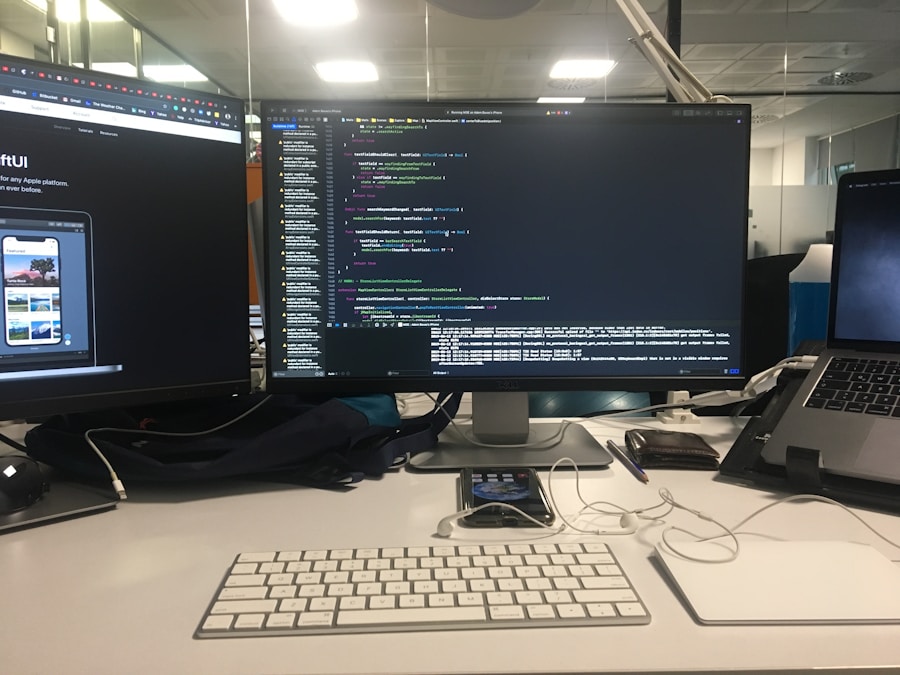As a startup founder, diving into the world of web development can feel overwhelming at first. However, understanding the basics of HTML, CSS, and JavaScript is essential for anyone looking to create a compelling online presence. HTML, or HyperText Markup Language, serves as the backbone of any website.
It structures the content, allowing you to define elements like headings, paragraphs, images, and links. Think of HTML as the skeleton of your website; without it, there’s no form or function. CSS, or Cascading Style Sheets, is where the magic happens in terms of aesthetics.
It allows you to style your HTML elements, giving your website its unique look and feel. With CSS, you can control colors, fonts, layouts, and even animations. Imagine walking into a room with bare walls; it’s functional but lacks personality.
CSS is what transforms that empty space into a vibrant environment that reflects your brand’s identity. JavaScript is the final piece of the puzzle. It adds interactivity to your website, allowing users to engage with your content dynamically.
From simple tasks like form validation to complex features like real-time updates and animations, JavaScript breathes life into your site. As a founder, grasping these three technologies will empower you to communicate effectively with your development team and make informed decisions about your product’s design and functionality.
Key Takeaways
- HTML, CSS, and JavaScript are the fundamental building blocks of web development.
- Responsive web design and mobile development are essential for creating user-friendly and accessible websites.
- Frontend frameworks and libraries like React and Angular can streamline development and enhance user experience.
- Version control with Git is crucial for managing and tracking changes in code and collaborating with other developers.
- Testing and debugging techniques are vital for ensuring the functionality and reliability of frontend code.
Learning Responsive Web Design and Mobile Development
Key Concepts for Achieving Responsive Web Design
To achieve responsive web design, you’ll need to familiarize yourself with concepts like fluid grids, flexible images, and media queries. Fluid grids allow you to create layouts that adjust based on the screen size, while flexible images ensure that visuals scale appropriately without losing quality. Media queries are CSS techniques that enable you to apply different styles based on the device’s characteristics.
Mobile Development and Responsive Design
Mobile development goes hand-in-hand with responsive design. As a startup founder, you should consider whether a mobile app or a mobile-optimized website is the best route for your business. Each option has its pros and cons.
On the other hand, a mobile-optimized website is easier to maintain and can reach a broader audience without requiring users to download anything.
Making Strategic Decisions
Understanding these nuances will help you make strategic decisions that align with your business goals. By mastering the concepts of responsive web design and considering the pros and cons of mobile development options, you’ll be able to create a user-friendly experience that keeps visitors engaged and drives business success.
Utilizing Frontend Frameworks and Libraries
Once you’ve grasped the fundamentals of HTML, CSS, and JavaScript, it’s time to explore frontend frameworks and libraries that can streamline your development process. Frameworks like React, Angular, and Vue.js provide pre-built components and tools that can significantly speed up your project’s timeline. They allow you to focus on building features rather than reinventing the wheel for every new project.
For instance, React is particularly popular for its component-based architecture, which promotes reusability and maintainability. This means that once you create a component—like a button or a form—you can use it across multiple parts of your application without having to code it from scratch each time. This not only saves time but also ensures consistency in design and functionality.
Libraries like jQuery can also be incredibly useful for simplifying common JavaScript tasks. While modern frameworks have reduced the need for jQuery in many cases, it still offers handy utilities for DOM manipulation and event handling. As a founder, leveraging these tools can help you build robust applications more efficiently while allowing your development team to focus on innovation rather than repetitive tasks.
Implementing Version Control with Git
| Metrics | Value |
|---|---|
| Number of Commits | 1500 |
| Number of Branches | 25 |
| Number of Contributors | 30 |
| Number of Merged Pull Requests | 200 |
| Number of Open Issues | 10 |
As your startup grows and your team expands, implementing version control becomes essential for maintaining order in your codebase. Git is the most widely used version control system today, allowing developers to track changes in their code over time. This means that if something goes wrong—whether it’s a bug introduced by new code or an accidental deletion—you can easily revert back to a previous version without losing all your progress.
Using Git also facilitates collaboration among team members. Multiple developers can work on different features simultaneously without stepping on each other’s toes. By creating branches for each feature or bug fix, developers can work independently and merge their changes back into the main codebase once they’re ready.
This not only enhances productivity but also minimizes conflicts that can arise when multiple people are working on the same files. As a founder, understanding Git will help you appreciate the importance of code management in your startup’s development process. It fosters a culture of collaboration and accountability within your team while ensuring that your project remains organized as it scales.
If you’re not already using Git, I highly recommend integrating it into your workflow as soon as possible.
Testing and Debugging Techniques for Frontend Development
Testing and debugging are critical components of frontend development that often get overlooked in the hustle of launching a startup. However, investing time in these processes can save you from significant headaches down the line. Testing ensures that your application functions as intended across various devices and browsers while debugging helps identify and fix issues before they reach your users.
There are several types of testing you should consider implementing: unit testing, integration testing, and end-to-end testing. Unit testing focuses on individual components or functions within your application to ensure they work correctly in isolation. Integration testing checks how different parts of your application interact with each other, while end-to-end testing simulates real user scenarios to verify that everything works together seamlessly.
Debugging tools like Chrome DevTools can be invaluable for identifying issues in your code. They allow you to inspect elements on your webpage, monitor network requests, and even simulate different device environments. As a founder, fostering a culture of thorough testing and debugging within your team will lead to higher-quality products and ultimately enhance user satisfaction.
Improving Performance with Optimization and Caching
Website performance is crucial for user experience and search engine rankings. Slow-loading sites can lead to high bounce rates and lost opportunities for engagement or sales. As a startup founder, understanding how to optimize your website’s performance should be a top priority.
One effective way to improve performance is through optimization techniques such as minification and compression. Minification involves removing unnecessary characters from your code—like whitespace and comments—without affecting its functionality. Compression reduces file sizes by encoding data more efficiently before sending it over the network.
Both techniques can significantly decrease load times and enhance user experience. Caching is another powerful tool for improving performance. By storing frequently accessed data temporarily in memory or on disk, caching reduces the need for repeated requests to the server.
This means that returning visitors can access your site much faster since their browser retrieves cached data instead of fetching it anew each time. Implementing caching strategies can lead to substantial performance gains and create a smoother experience for users.
Staying Updated with the Latest Web Development Trends
The world of web development is constantly evolving, with new technologies and trends emerging regularly. As a startup founder, staying updated with these changes is essential for maintaining a competitive edge in the market. Following industry blogs, attending conferences, and participating in online communities can help you keep your finger on the pulse of web development trends.
For instance, progressive web apps (PWAs) have gained popularity due to their ability to provide app-like experiences directly through web browsers. They combine the best features of both websites and mobile applications, offering offline capabilities and push notifications without requiring users to download anything from an app store. Understanding trends like this can help you make informed decisions about how to position your product in the market.
Additionally, keeping an eye on emerging technologies such as artificial intelligence (AI) and machine learning (ML) can open up new possibilities for enhancing user experiences on your platform. By integrating these technologies into your product roadmap early on, you’ll be better equipped to meet evolving user expectations and stay ahead of competitors.
Building a Strong Portfolio and Networking in the Frontend Development Community
As you embark on your journey as a startup founder in web development, building a strong portfolio is crucial for showcasing your skills and attracting potential clients or partners. Your portfolio should highlight not only completed projects but also demonstrate your problem-solving abilities and creativity in tackling challenges. Networking within the frontend development community can also provide valuable opportunities for collaboration and growth.
Attend local meetups or online webinars where you can connect with other developers and industry professionals who share similar interests. Engaging with this community can lead to partnerships that enhance your product offerings or provide insights into best practices. Don’t underestimate the power of social media platforms like LinkedIn or Twitter for building connections as well.
Sharing your knowledge through blog posts or engaging in discussions about industry trends can position you as a thought leader in the space while expanding your network. In conclusion, navigating the world of web development as a startup founder requires dedication and continuous learning. By understanding the basics of HTML, CSS, and JavaScript; embracing responsive design; utilizing frameworks; implementing version control; focusing on testing; optimizing performance; staying updated with trends; and building connections within the community—you’ll be well-equipped to turn your ideas into reality.
If you’re looking for a trusted tech partner to help bring your vision to life, consider Witarist as an extension of your team. We specialize in MVP development, product ideation, website/app creation, hiring vetted developers (part-time or full-time), and fostering startup tech partnerships that drive success. Let’s take this journey together—reach out today!
If you are a Frontend Developer looking to expand your team, you may want to consider hiring offshore development teams. This article on offshore development teams provides valuable insights on the benefits and challenges of working with remote teams. Additionally, if you are debating between using Django or PHP for your projects, this article on Django vs PHP can help you make an informed decision. And if you are in the process of hiring software developers to join your team, this article on how to hire software developers offers practical tips and strategies to find the right talent for your projects.
FAQs
What is a Frontend Developer?
A Frontend Developer is a type of web developer who focuses on the visual and interactive aspects of a website or web application. They are responsible for creating the user interface and ensuring that the website or application is visually appealing and easy to use.
What are the key responsibilities of a Frontend Developer?
Some key responsibilities of a Frontend Developer include creating and implementing web design and user interface elements, optimizing websites for speed and responsiveness, and collaborating with backend developers to integrate frontend and backend functionality.
What skills are required to become a Frontend Developer?
Frontend Developers should have a strong understanding of HTML, CSS, and JavaScript, as well as experience with frontend frameworks such as React, Angular, or Vue.js. They should also have a good eye for design and be familiar with responsive design principles.
What are some common tools and technologies used by Frontend Developers?
Frontend Developers often use code editors such as Visual Studio Code or Sublime Text, version control systems like Git, and task runners/build tools like Gulp or Webpack. They also frequently work with frontend libraries and frameworks such as Bootstrap, jQuery, and Sass.
What is the difference between a Frontend Developer and a Backend Developer?
While Frontend Developers focus on the visual and interactive aspects of a website or web application, Backend Developers are responsible for the server-side logic and database interactions that power the frontend. Frontend Developers work on the client side, while Backend Developers work on the server side.










